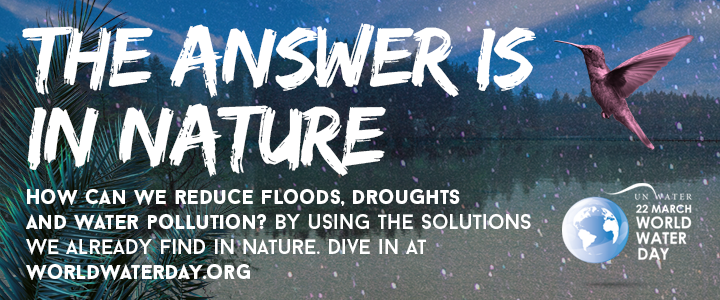World Water Day
World Water Day, 21st March 2018
This year’s theme – Nature for Water – explores how we can use nature to overcome the water challenges of the 21st century.
World Water Day, on 22 March every year, is about focusing attention on the importance of water. This year’s theme, ‘Nature for Water’, explores nature-based solutions (NBS) to the water challenges we face in the 21st century. The campaign is called ‘The answer is in nature’ and raises awareness of NBS. The central message is that NBS, such as planting trees to replenish forests, reconnecting rivers to floodplains, and restoring wetlands, is a sustainable and cost-effective way to help rebalance the water cycle, mitigate the effects of climate change and improve human health and livelihoods.
By using NBS to help meet the water needs of a growing population, we will contribute to the creation of a circular economy, at the same time as helping to protect the natural environment and reduce pollution – both key targets in Sustainable Development Goal 6, which commits the world to ensuring availability and sustainable management of water and sanitation for all by 2030.
The National Wellbeing Service Ltd is promoting World Water Day to its followers through its website, twitter and facebook pages. Please visit the World Water Day website to support the event.
Water demand:
• 2.1 billion people lack access to safely managed drinking water services.
• By 2050, the world’s population will have grown by an estimated 2 billion people and global water demand could be up to 30% higher than today.
• Agriculture currently accounts for 70% of global water withdrawals, mostly for irrigation – a figure which rises in areas of high water stress and population density. Industry takes 20% of the total, dominated by energy and manufacturing. The remaining 10% goes to domestic use – the proportion used for drinking water is much less than 1%.
Water availability:
• Today, around 1.9 billion people live in potentially severely water-scarce areas. By 2050, this could increase to around 3 billion people.
Water quality:
• An estimated 1.8 billion people use an unimproved source of drinking water with no protection against contamination from human faeces.
• Globally, over 80% of the wastewater generated by society flows back into the environment without being treated or reused.
WHAT ARE NATURE-BASED SOLUTIONS (NBS)?
Restoring forests, grasslands and natural wetlands, reconnecting rivers to floodplains, creating buffers of vegetation along water courses – these are all examples of NBS that help the management of water availability and quality.
Most NBS, including in urban landscapes, essentially involve the management of vegetation, soils and/or wetlands, including rivers and lakes. NBS are not a panacea to the critical water-related challenges we face as the global population grows, but they can provide innovative and cost-effective options for supplementing insufficient or ageing water infrastructure. For example:
- Water availability and supply: Water storage via natural wetlands, soil moisture and/or groundwater recharging can be more sustainable and cost-effective than grey infrastructure, such as dams.
- Water quality: Pollution from agriculture can be drastically reduced by NBS such as conservation agriculture, which protects soil from erosion, or riparian buffers, strips of land along water courses planted with native trees and shrubs.
- Risk management: The effects of climate change, such as frequent extreme flooding, can be mitigated by a range of NBS, such as riparian buffers or connecting rivers to floodplains.
The application of certain NBS creates what is known as ‘green infrastructure’: natural or semi-natural systems that give us equivalent or similar benefits to conventional, human-built
‘grey infrastructure’. NBS often produce benefits beyond water-related services. For example, constructed wetlands used for wastewater treatment can provide biomass for energy production,
improve biodiversity and create recreational spaces and associated employment.
Visit the website for more information about World Water Day.
We thank United Nations Water for providing the information and facts for this webpage.
